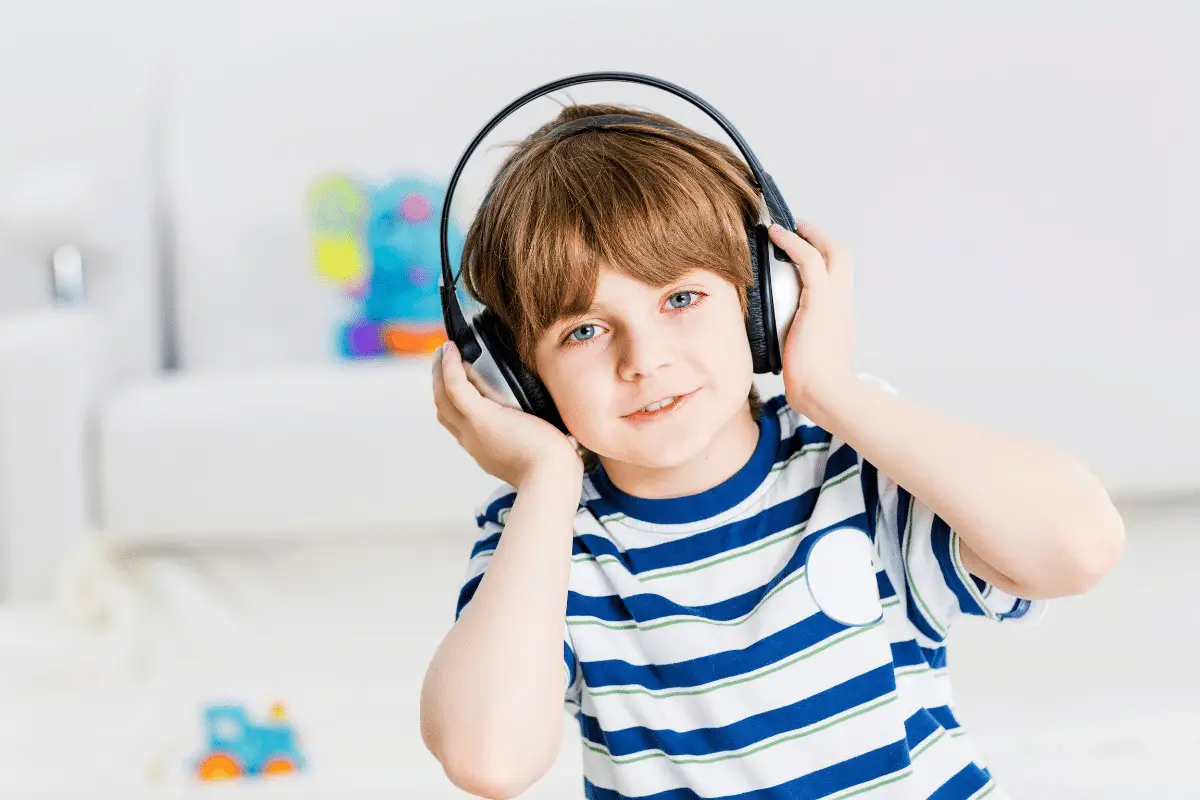First-grade music is a fun place to be! They have all the energy of Kindergarten, but they’re much less like herding cats!
The folk songs and music games are simple and usually quick, but this doesn’t make them any less effective in teaching basic music concepts and inspiring a love of music from an early age.
With this in mind, I looked through my resources and picked my 11 favorite 1st-grade music lesson plans to share with you.
Happy teaching!

Save time with these 60 FREE Music Resources to use in your room right away!
Stop searching the whole internet to find good activities. I’ll help you cut to the chase with my favorite 60 FREE resources.
Table of Contents
My Aunt Came Back
Echo songs are the bomb with younger grades.
They’re easy to use right away, and you don’t have to “teach” them.
Just say, “sing what I sing and do what I do,” and you’re off! (Plus, it’s great for developing independent singing voices!)
This echo song is a blast to do because it’s an adding movement song.
Every verse adds a new motion, ending in a very silly-looking movement.
Then, the twist at the end is adorable as you call each other “nuts!” for your moves.
Normally, I’d post the sheet music here, but since the source I have is the song from is a current book, I want to be respectful of that.
I first heard it from John Feierabend and his book (click the link to find it on Amazon).
Also check out Feierabend’s program, Conversational Solfege, in our detailed guide.
I will tell you the moves I do with this song. Each verse adds the move, so you end up doing them all at one time:
- Wooden shoe = Walk in place
- Waving fan = One hands waves
- Pair of shears = Other hand makes a cutting motion
- Hula-hoop = Move hips around
- Rocking chair = Upper body moves back and forth
- Nut like you! = Stop and point at each other
Here’s a video of the book to help you learn the song:
You may also want to check out the Green Grass Grew All Around as another example of an echo song. Click the link for our sheet music and lesson guide.
Ickle Ockle
In first grade, we spend the first chunk (or sometimes the whole year) practicing the steady beat.
There’s no better way to practice steady beat than through movement!
Ickle Ockle is a fun, nonsense song that’ll help your students connect to the beat.
Later on, you’ll be able to connect this with rhythms, including quarter notes, eighth notes, and quarter rests, if you teach this in first grade.
Here’s the musical score:
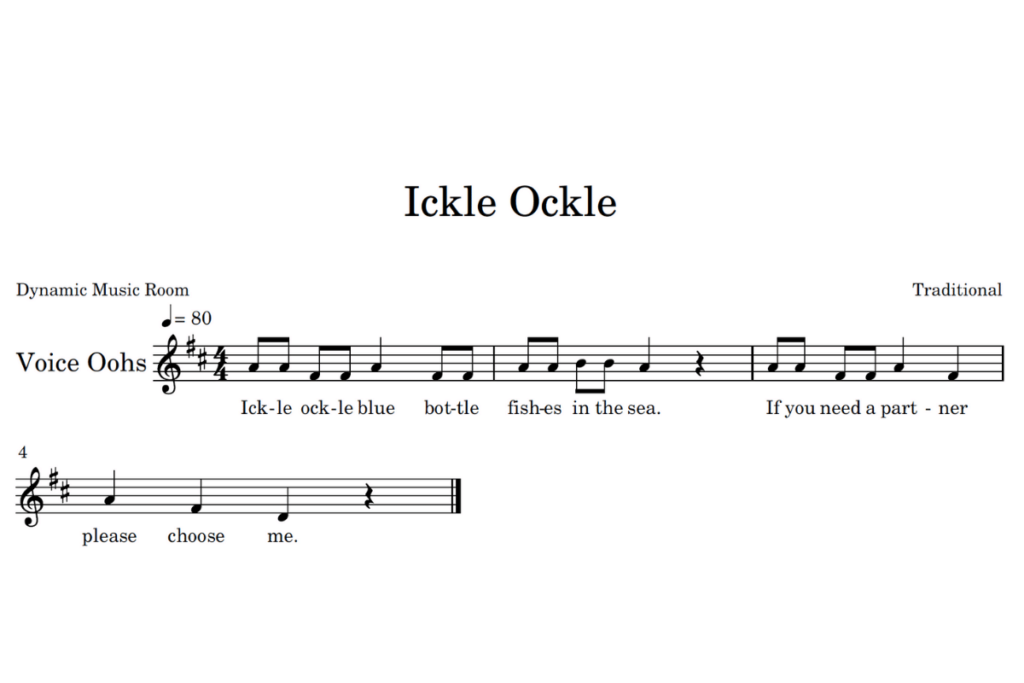
The game is pretty simple. Students stand in a circle and clap their hands to the beat.
One student skips or marches around the inside of the circle.
On the words “please choose me,” the inner person shakes someone else’s hand, takes their spot, and has a seat.
Repeat until all have had a turn.
After students get the game, I usually pick three or four IT people to help the game go a little faster. Otherwise, it takes a long time to finish.
Check out our detailed article on Ickle Ockle including sample lessons.
I Can Play A Rhythm
Here’s a simple song I made up in my student teaching.
Is it going to win any awards? Probably not, but I like it, and my kids do too!
I typically play this where we sit in a circle, and every fourth student has rhythm sticks.
We sing the song while tapping the steady beat. After the song, we add a B section where students improvise their own rhythms and play the sticks.
I let the people who have the sticks take turns individually improvising, first by clicking and saying a sentence about themselves (“My name is Billy, and I like pizza.), and then by using rhythm syllables.
Check out the musical notation here:
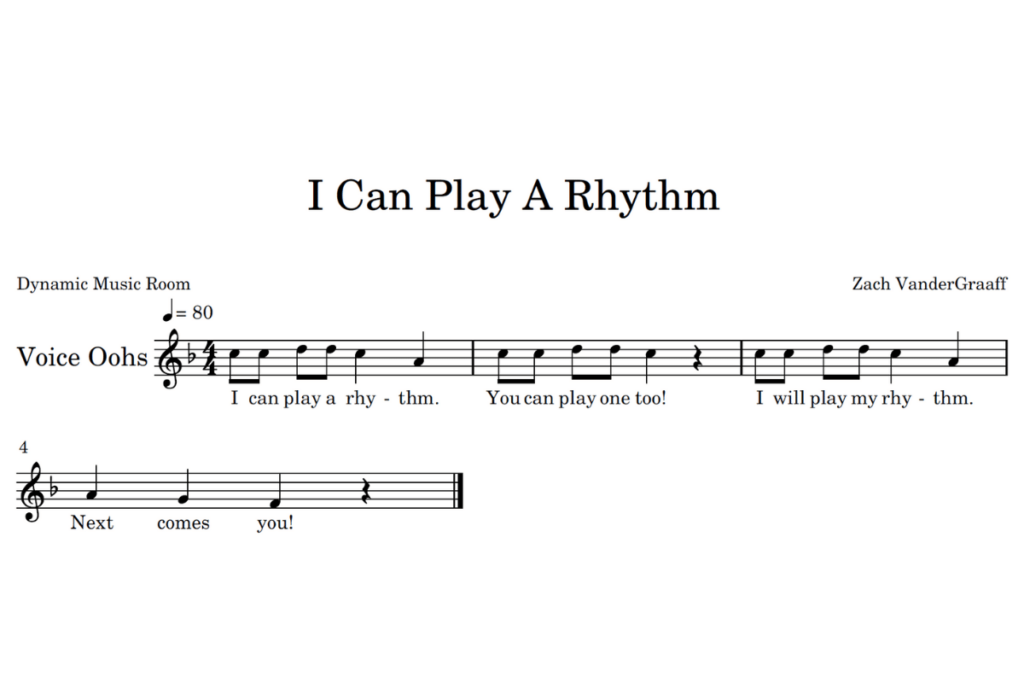
The Crabfish
It’s important for kids to relax and listen to different songs too.
The Crabfish is an old song with a new book and safer lyrics in a beautifully modal melody.
I put this in my first-grade list, but I also share this song and book with Kindergarten and 2nd grade.
I usually don’t have students do anything other than listen and watch the song-story.
Here’s a video of the song:
If you want the beautifully illustrated book, click the link to check the price on Amazon.
You may also want to check out my research on the Crabfish lyrics in this article.
Bow Wow Wow
Bow Wow Wow is one of the easiest singing games and a classic in the music education world.
It’s perfect for teaching quarter rest and emphasizing the pentatonic scale with singing voices.
Here’s the sheet music:
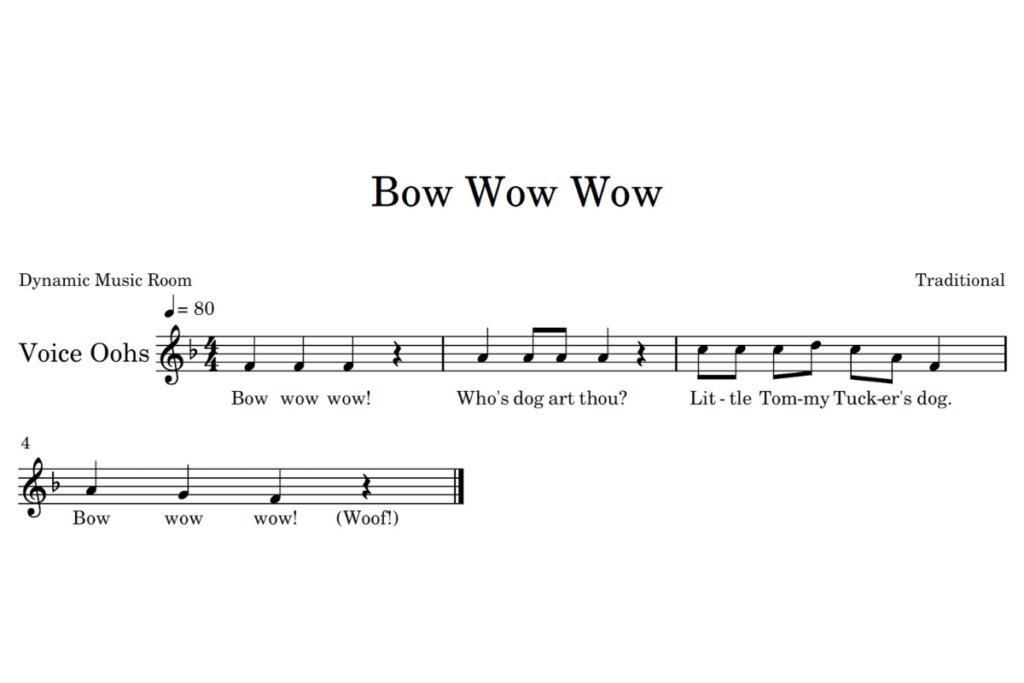
The game is easy. Students stand facing a partner; they can be in a circle or scattered around the room:
Check out the game and detailed breakdown for Bow Wow Wow at the link.
Cuckoo! How Are You?
This is a game I learned from Paul Rose, a retired music teacher from Mount Pleasant in Michigan.
It’s basically just a bunch of echoes on sol-mi or whatever pitches you want to emphasize.
I do this with first grade, but I’ve even done it using more advanced pitch concepts with my older students.
It works with Kindergarten to work on head voices/singing voices.
The game comes in two parts:
Part 1: The Copying
During this section, students (sitting in a circle) close their eyes and put their hands behind their back.
The teacher sings, and the students echo while the teacher hands out objects like egg shakers or puppets to a few students.
Here are some things I sing (usually to sol-mi):
- Cuckoo!
- How are you?
- Cuckoo!
- The sky is blue.
- Cuckoo! (I sing this every other time)
- I like you.
- Cuckoo-ca-choo!
- Yabadabadoo!
- Scooby-doo!
- Don’t eat glue!
- We are through!
Part 2: The Singing And Throwing
In the middle of the circle is a large flat drum. Students will try and throw the object into the drum.
You pick who throws by singing: “Who has the blue egg?”
The person who has the egg holds it up, and the class sings: “Billy has the blue egg.” Or whatever their name is.
Pro-tip: Later in the year, have the student who has the egg sing by themself: “I have the blue egg.”
After all eggs (or puppets) are thrown, collect the objects and start the first part over again.
Repeat until everyone has had a turn.
Lucy Locket
Lucy Locket is a fun guessing game for this grade level and fits in with the whole quarter notes and eighth notes rhythm set AND the sol-mi-la pitch patterns that many music teachers use with this age group.
One person closes their eyes while you give the “locket” to another student. The rest of the class sings while you hand it out.
At the end of the song, the guesser opens their eyes and has three guesses to figure out who has it.
Then, the person you picked becomes the new guesser, and you repeat until all have had a turn or they get bored.
This song is similar in the game to others like Doggy, Doggy, Where’s Your Bone? (click the link for my deep-dive article) and Closet Key, which makes my list of the best 2nd-grade music lesson plans.
Here’s the traditional notation at the American Folk Song Collection.
Here Comes A Bluebird
There are many variations of this song I’ve seen in the elementary music classroom.
Some are simplified versions of the same song.
Here’s the musical score to the one I use:
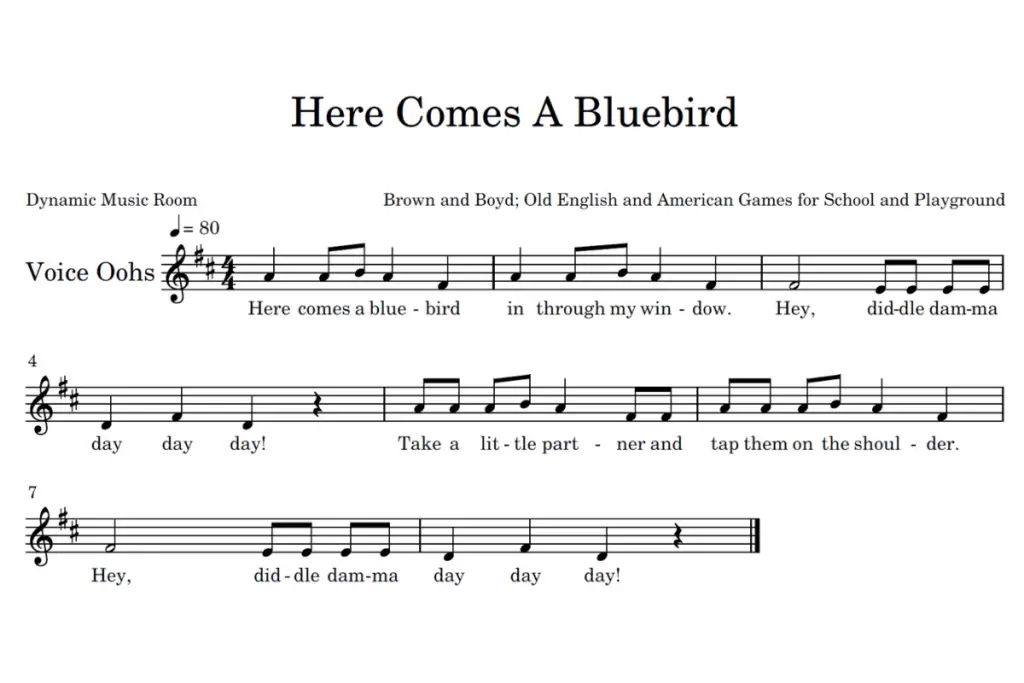
For this game, students are standing in a circle while one student flaps around the group.
At the words, “take another partner and tap ’em on the shoulder,” the leader taps a student. This new student becomes the leader, and the former leader puts their hands on the new leader’s shoulders to form a line of two.
The game repeats until you have one giant bird line flapping around the room.
Like many other games, I’ll sometimes have multiple leaders to get through turns faster.
This works better when I’m working with my 30+ person first-grade music classes.
Hickety Tickety Bumblebee
On the first day of music class, it’s important for me to practice names.
While seating charts may help, even then, it’s tough to learn all the names.
After all, we have more students than any other teacher (except our other special area people).
Simply tap a beat during the song. After it’s done, say your name and tap a drum.
Now, either pass the drum or walk around holding the drum and let the students say their names and play the drum.
Easy, but fun!
It’s funny, but I always remembered this as Hickety Tickety, but most people have it as Hickety Pickety.
I’m probably just remembering wrong from my childhood.
The notation can be found at Beth’s Music.
The Pirate Song
I first heard this modal song at the Michigan Music Conference from Deb Navin, a fellow music teacher.
The song is in Dorian, which makes it unique enough on its own.
It’s also fun to play with a stretchy band as you review the basics of music, especially around the steady beat and the fluid movement expressions that can come with it.
On a stretchy band (the big rainbow one!), tie a scarf. Students pull the band around in a circle while they sit.
At the end of the song, they stop on the words, “Who is the captain now?”
Whoever has the scarf in front of them is the new captain, and the class sings: “Billy is the captain now!”
Here’s the notation:
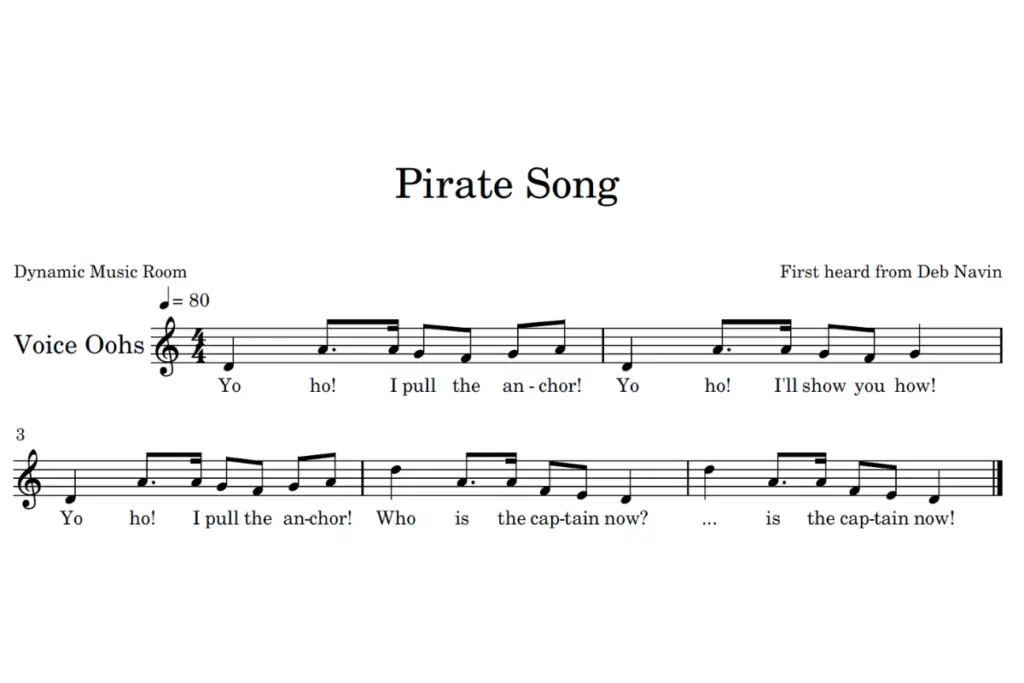
London Bridge
London Bridge is certainly easy, and it’s really a classic.
I almost didn’t put it on here, assuming most people use this song.
But in my experience, many of our folk songs and nursery rhymes are being forgotten.
While this is great in some cases (looking at you, songs-rooted-in-racism), some shouldn’t be forgotten.
I think one of these is London Bridge.
Watch this video for how to play the game (with a unique twist!):

